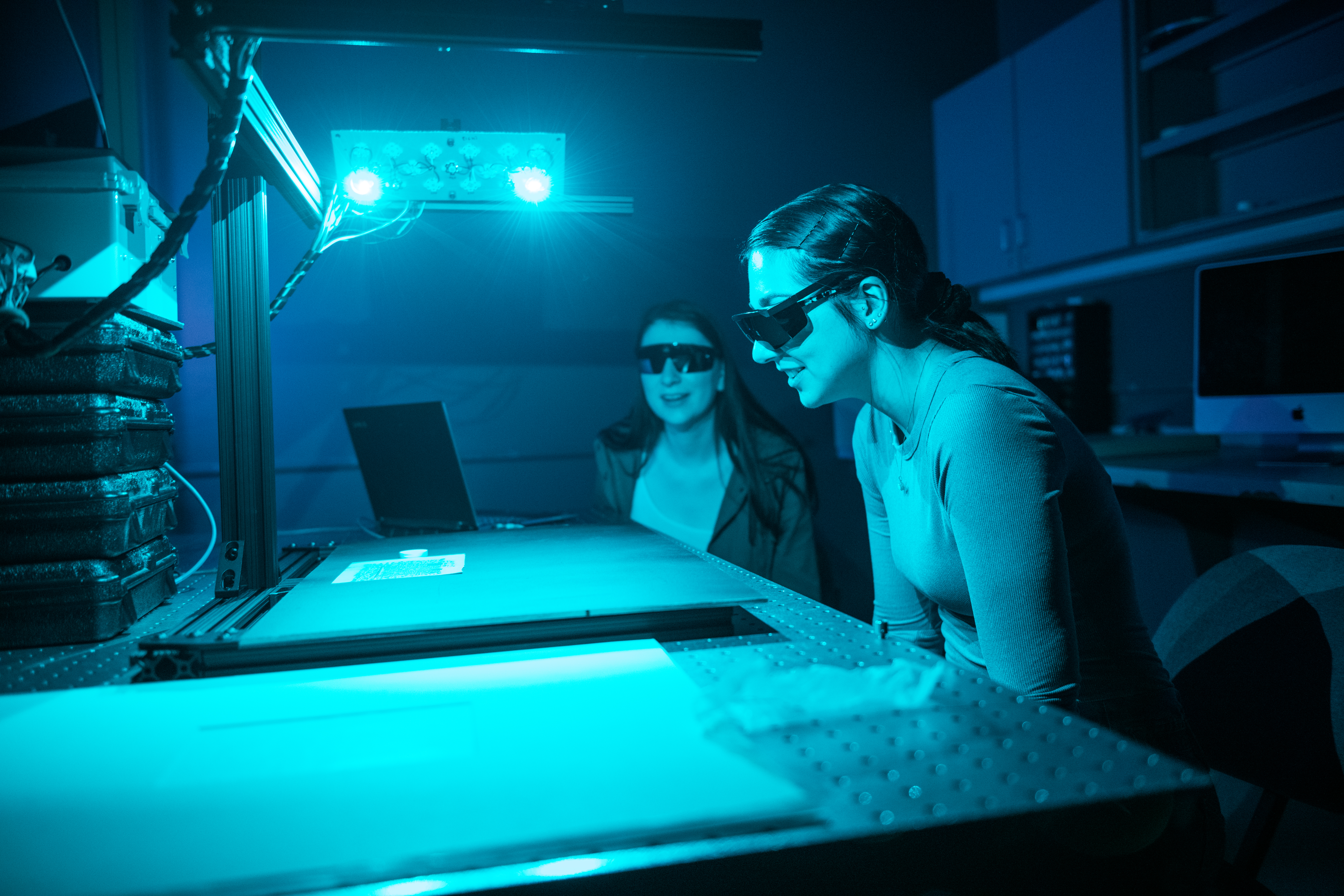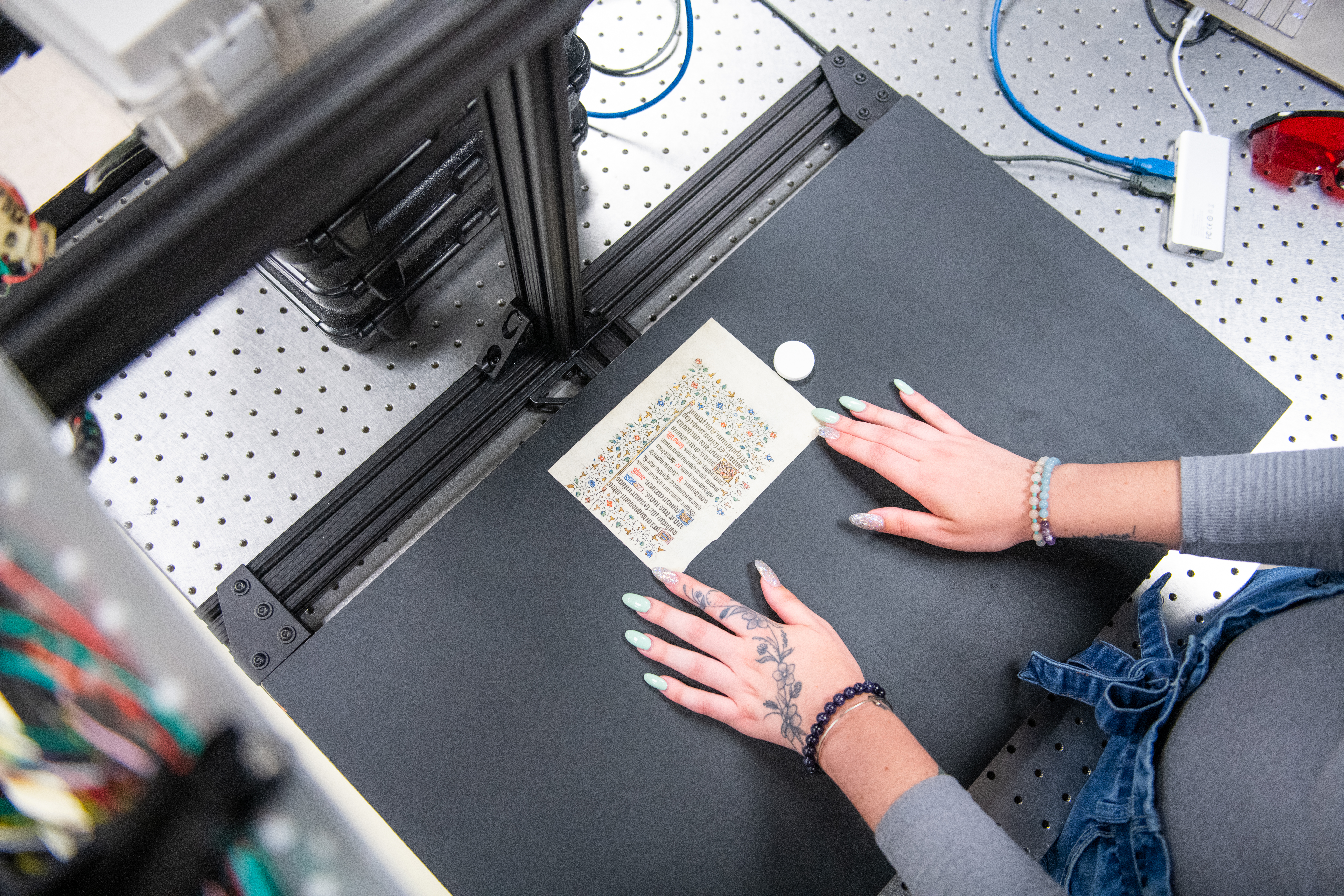The Rochester Institute of Technology’s Chester F. Carlson Center for Imaging Science is developing an affordable imaging system to help museums and libraries preserve and expand access to their collections. Funded by the National Endowment of the Humanities, this project aims to create low-cost spectral imaging systems and software to recover obscured and illegible text on historical documents. This past summer, RIT’s Imaging Science Department partnered with RIT’s Museum Studies department to bring this system and software to three cultural organizations: the Rochester Public Library, Rochester Museum & Science Center, and Genesee Country Village & Museum. Students scanned 50 documents and artifacts and provided feedback to the Image Science Department.

Working with scientist Tania Kleynhans, Ph.D. (Imaging Science) system, Courtney Barber and Katie Keegan, class of 2021 museum studies graduates, are testing a multispectral imaging system created at RIT and intended to expand access to materials by revealing content that may not be immediately visible due to damage, deterioration, or erasure. This project has been made possible in part by a major grant from the National Endowment for the Humanities. Photo by Gabrielle Plucknette-DeVito, courtesy of RIT Museum Studies Program.
Spectral Imaging
Spectral imaging collects images of objects across the wavelengths of light and is an effective way to reveal fading text on historic documents undetectable to the human eye. “If you take a photo with your cell phone, the camera only captures three wavelengths of light–red, blue, and green. Any normal photograph has those three colors because that’s how our eyes work. It’s what we see,” said Tania Kleynhans, Associate Scientist at the RIT Chester F. Carlson Center for Imaging Science. “But there are a lot of colors that also have what we would call information. So if it’s a red shirt, only the red light is reflected off of it. What we do with our system is capture the in-between red and green and in-between green and blue and then also further into the shoulder of wavelengths of colors from the ultraviolet to infrared,” explained Kleynhans. “It captures the colors that our eyes can’t see.” Kleynhans and her team developed the software for this system to be able to capture 16 different colors. “Normal software programs like Photoshop are not really geared towards working with pictures that aren’t in three colors.”

Using spectral imaging, the process of capturing images of objects in many colors or wavelengths of light, to reveal obscured or illegible text and drawings, museum studies students are imaging historical documents to reveal content that may not be immediately visible due to damage, deterioration, or erasure. The images are acquired by lighting the object with sixteen narrow-band LED sets that are used to illuminate the object, one set at a time. Photo by Gabrielle Plucknette-DeVito, courtesy of RIT Museum Studies Program.
Testing the System
Once the system and software were developed, RIT worked with its Museum Studies undergraduate program and travelled with the system to the Rochester Public Library, Rochester Museum & Science Center, and Genesee Country Village & Museum.
“I choose these three institutions specifically because I wanted to have three different types of institutions like an AAM accredited science museum, a library that may have massive documents, and then another collecting museum that has a lot of assorted materials,” said Dr. Juilee Decker, Professor and Director of the RIT Museum Studies program. “Part of what the students were doing was not just testing the software to help the system become more efficient and user friendly, but also tasked with instruction writing for building and breaking down the system.”
The imaging science team was able to build something that was relatively low cost. These systems normally cost hundreds of thousands of dollars, this new system costs between $5,000 and $20,000.
Large institutions, like the National Gallery in the UK have conservation labs with systems like this for use on-site. They are usually framed within the construct of conservation and conservation science. “For me I see this as preventative conservation because discoverability was our goal with the grant, but you can also use the system to see if there are initial stages of wear or deterioration,” said Dr. Decker.
“A big part of what helped by having this system travel to different sites was to show the curators that it’s not something to be afraid of and that it is something easy to do,” said Kleynhans. “It is possible if you need to use it, use it.”
Kleynhans noted that while the system has had some great success, it’s also not magic. “Sometimes the [faded or illegible text] is just not there but we can enhance certain areas of a document or can make changes to the color of the document that can make it easier to visualize which does help a lot.”
“Our goal for this project primarily was discoverability and accessibility. I think that RIT was well-positioned with having both the image science program as well as the undergraduate museum studies program that is predicated around collections, hands-on-experiences, and the intersection of technology. I think this was the perfect match for us.”
Partner Experience and Discoveries
For Brandon Fess, Librarian at the Rochester Public Library participating in this project was a “no brainer.” “I’d known Juilee [Dr. Decker] for a number of years and she put me in touch with Tania Kleynhans and the rest of the team from the image science department,” said Fess. The library has a fairly modern collection but Fess identified a number of historical documents about which they had questions.
One of these historical documents is an 1816 pamphlet about a proposed canal project. “There’s seemingly a blank page and we’ve been trying to figure out if this page was intentionally left blank, missed by the printer, or since it’s iron gall ink, did that page fade?” said Fess. He hasn’t seen the final images yet, but imaging thus far did reveal text on the page but it is still to be determined if it was faded text or reverse text burn from the page underneath.
Another document was a 1792 manuscript map that shows the modern town of Irondequoit in the northeastern part of the city of Rochester. “The map interested us because it was rediscovered in our collection three years ago. It’s a manuscript piece on valium and it's been hard for me to tell if the map had been an actual draft or if it was a manuscript copy,” said Fess. “Because of the work of the students and Tania [Kleynhans] it is now clear that it is a manuscript copy which helps us contextualize it because we know it is not the only map showing this exact area of that time period. It appears that several of these maps were drawn by the same draftsman for the partners involved with the division of land in that township.”
The Rochester Public Library also has a large Sanborn map collection. “With Sanborn maps there’s always the issue of having paste-ins. I have yet to see an unpasted Sanborn map. So I kind of tossed it out there to the team to see if we could read what was underneath the paste downs,” said Fess. “The team said sure we’ll give it a try–not thinking that it’ll work . But when I saw the preliminary results, the team and I were surprised because you could actually see through the paste downs and in fact you could see them quite well.” For Fess and the Rochester Public Library it was an unexpected but appreciated opportunity. “We definitely want to follow up on the 1816 canal pamphlet and would almost certainly want to do a digital reconstruction of the whole pamphlet to make it available.”
Genesee Country Village & Museum provided a few objects, maps, and journals to the team. “There wasn’t anything that was quite shocking or revealing. I think one coolest things was we were able to see one of the diaries that had a lot of cross outs. It was difficult to read and the imaging allowed us to read what was underneath those cross outs,” said Amanda Wilck, Collections Manager at GCV&M. “We were able to find out that this woman who owned this diary had actually reconstructed her entire list about spinning and the different types of spinning so instead of having ten points there are nine because she crossed one out. It was really interesting to see that in real time and to just read out loud together with the researchers what was being said and learn new information.”
The RIT team also experimented with scanning a 3D object at GCV&M, a medicine bottle from the mid-1800s. “It is a black medicine bottle that is maybe the size of a liquor bottle today,” said Dr. Decker. “It was really dirty and the label was barely visible but when we imaged it you could really see the imagery on the label pop out and reveal a lot of the details.” Wilck and her colleagues found a reference image online to confirm the label on the bottle. “It was also a case to say that we can actually image 3D items,” said Decker.
“It was really amazing to see these students get out in the field and do the work,” said Wilck. “They put the whole machine together by themselves. It’s really encouraging to see RIT and its museum studies program move towards that technological route and give their students the agency to get a project like this done.”
 Students examine a medieval document from the Cary Graphic Arts Collection. Photo by Gabrielle Plucknette-DeVito, courtesy of RIT Museum Studies Program.
Students examine a medieval document from the Cary Graphic Arts Collection. Photo by Gabrielle Plucknette-DeVito, courtesy of RIT Museum Studies Program.
What’s Next
RIT hopes that in the next year and a half of the NEH grant to have as many different universities, museums, and libraries using the system and software. “We want to show people what’s available and how it works,” said Kleynhans. At the end of the grant, the documentation for the system and software will be open source and available online for other institutions to use. “A museum or library likely won’t build it themselves, but there are many universities that have engineering departments and their students are often looking for projects for their senior capstones and with information that we supply can be built in-house.”
RIT wants more museums to come to their imaging science team with their historical documents and use the system and software. “We’re trying to find objects to see what the limitations are with the system,” said Kleynhans.
“The capacity and the ability that we have as an education system to share this tool and to make it more accessible to institutions across the state is really important to me because part of what we do at RIT and our programs is to provide opportunities for our students who are emerging professionals to work in this space and learn how to use this technology,” said Dr. Decker. “So I feel like we have a real commitment to try to share the knowledge and the capacity that we have here. I don’t want anyone to feel that this is beyond their reach because part of what we’re trying to do is to make this accessible.”
Learn more: https://www.rit.edu/science/spotlights/rit-students-discover-hidden-15th-century-text-medieval-manuscripts
